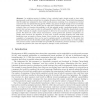42 search results - page 5 / 9 » The Tile Complexity of Linear Assemblies |
CIE
2010
Springer
14 years 7 days ago
2010
Springer
The Tile Assembly Model is a Turing universal model that Winfree introduced in order to study the nanoscale self-assembly of complex (typically aperiodic) DNA crystals. Winfree ex...
STOC
2001
ACM
14 years 7 months ago
2001
ACM
Recently Rothemund and Winfree 6] have considered the program size complexity of constructing squares by selfassembly. Here, we consider the time complexity of such constructions ...
STACS
2007
Springer
14 years 1 months ago
2007
Springer
Abstract. We give a characterization, in terms of computational complexity, of the family Rec1 of the unary picture languages that are tiling recognizable. We introduce quasi-unary...
NC
2008
13 years 7 months ago
2008
An enduring mystery in biology is how a physical entity simple enough to have arisen spontaneously could have evolved into the complex life seen on Earth today. Cairns-Smith has pr...
DNA
2008
Springer
13 years 9 months ago
2008
Springer
Abstract. Nature is considered one promising area to search for inspiration in designing robotic systems. Some work in swarm robotics has tried to build systems that resemble distr...

